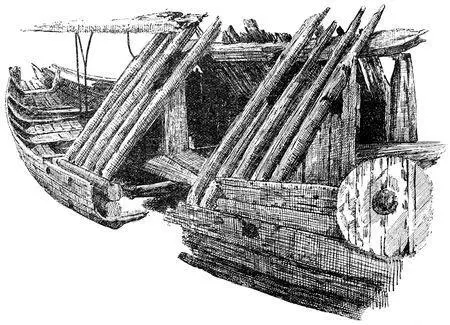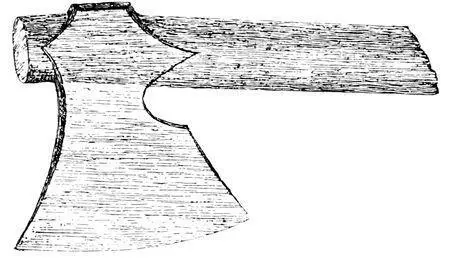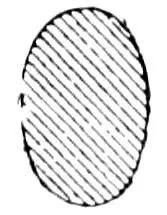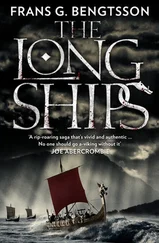“The Asar took the body of Baldr and carried it down to the sea. Hringhorni was the name of Baldr’s ship; it was larger than any other ship. The gods wanted to launch it for the burning-voyage of Baldr, but it did not move. Then the gyg (Jötun-woman) 211in Jötunheim, named Hyrrokkin, was sent for. She came riding on a wolf, with snakes for reins. She leapt from the steed, and Odin called to four Berserks to take care of it, but they could not hold it except by throwing it down. She went to the stem of the ship and pushed it forward at the first attempt, so that fire issued from the rollers and the ground trembled. Then Thor grew angry, seized his hammer, and would have broken her head if the gods had not asked him to spare her. The body of Baldr was carried out on the ship, and his wife Nanna, Nep’s daughter, on seeing this died from grief. She was laid on the pyre and it was set on fire. Thor went to it and consecrated it with Mjölnir . At his feet there ran a Dverg named Lit. Thor pushed him with his foot into the fire, and he was burned. To this burning came many kinds of people. First went Odin and his ravens and Frigg, as well as the Valkyrias. Frey drove in a carriage drawn by the boar called Gullinbursti (gold bristle) or Slidrugtanni (the awful-tusked). Heimdal rode the horse Gulltopp (gold tuft), and Freyja with her cats. There came also many Hrim Thursar and Bergrisar. Odin laid on the pyre the gold ring Draupnir ; afterwards every ninth night there dropped from it eight equally heavy gold rings. The horse of Baldr was led on the pyre in full harness” (Gylfaginning, ch. 49).
“They carried him in the snowstorm to Naustanes, where a tent was put over him at night. In the morning, at high water, Skallagrim was laid in a ship, and they rowed to Digranes. Egil had a mound made near the end of the ness (cape), and in this he was laid, with his horse, his weapons, and smithying tools. It is not mentioned that loose property was put in the mound with him. Egil took the inheritance, lands, and loose property; he took care of the farm” (Egil’s Saga, c. 61).
Gudrun after having slain her husband Atli said:
I will buy a ship (knörr), 212
And a painted coffin,
Wax well the sheets 213
To wrap thy corpse with;
Think of every need,
As if we were friends.
“Geirmund died at Geirmundsstadir, and was laid in a ship in the woods near the farm (gard).”
Of this Geirmund much is told of in Sturlunga as a great chief.
“Thórir, An’s brother, fell in a battle against king Lugjaldi of Naumdœlafylki.
“An had a mound made and put a ship in it and placed Thórir in its lypting, but the king’s men he placed along both sides of the ship that it might look as if all served him” (An Bogsveigi’s Saga, ch. 6).
“The brothers Eirik and Jorund became very famous by this deed (slaying King Gudlaug of Hálogaland), and they thought themselves far greater men than before. When they heard that King Haki had allowed his champions to go away, they sailed to Sweden and collected a host, and when it was known that the two Ynglings had returned the Swedes flocked to them in great numbers. They sailed up into the Log (Lake Mälar) and went to Uppsalir against King Haki, who met them on Fyrisvellir. A great battle ensued; King Haki rushed forward with such valour that he slew all that were near him, he finally killed Eirik and cut down the standard bearers of the brothers, whereupon Jorund fled to his ship with his men. Haki received such severe wounds that he saw his days would not be long. He then had a skeid which he owned loaded with dead men and weapons, he had it launched on the sea, and the rudder adjusted and the sea sail hoisted. He had tarred wood kindled and a pyre made on the ship, the wind blew towards the sea. Haki was almost dead when he was laid on the pyre. Then the burning ship sailed out to sea. This was very famous for a long time after” (Ynglinga Saga, c. 27).
“King Hakon then took the ships belonging to Eirik’s sons, which lay on the dry beach, and had them dragged ashore. He placed Egil Ullserk, together with all who had fallen on his side, in a ship, which was covered with earth and stones. He also had dragged ashore several more ships, and into these were laid the dead. The mounds are still to be seen south of Frædarberg. High bautastones stand at the mound of Egil Ullserk” (Hakon the Good’s Saga, ch. 27).
Women were sometimes buried in ships.
“After this Unn, who was now quite old, as was her custom, went into her sleeping-house to rest, but bade her guests enjoy themselves, and ordered that they be entertained as splendidly as possible. When she retired the feast continued until it was time to go to bed. The next day, as Unn remained longer than usual in her sleeping-room, Olaf went in and found her dead. He returned to the guests and announced this to them, who all said that Unn had well kept up her dignity to the last.
“At the same time Olaf’s wedding and Unn’s arvel were held. On the last day of the feast her body was carried to the mound which had been prepared for it. She was placed in a ship therein, and with her a great deal of property, and then the mound was closed.” Olaf then took possession of his grandmother’s property, and, after the feast was over, gave fine presents to the foremost of those present, and all departed (Laxdæla, ch. 8). 214
Men were sometimes buried in a ship’s boat.
“Ingimund was laid in the boat of the ship Stigandi, and his body prepared honourably as was the custom with high-born men. Thorstein said to his brothers: ‘It seems to me right that we shall not sit in our father’s seat at home, or at feasts, while his slaying is unavenged.’ This they did, and neither went to games nor other gatherings” (Vatnsdæla Saga, 22).
One of the most valuable discoveries, showing the burial of a warrior in a ship without his body being burned, is that of the Gökstad ship.
Very few things in the North have impressed me more than the sight of this weird 215mausoleum, the last resting-place of a warrior, and as I gazed on its dark timber I could almost imagine that I could still see the gory traces of the struggle and the closing scene of burial when he was put in the mortuary chamber that had been made for him on board the craft he commanded.

Fig. 747.—Sepulchral chamber, Gökstad ship.
The greatest length of the mound was from N.E. to S.W. About 150 feet in diameter, height above the soil 15 feet; above the sea 18 feet. The roof of the structure had been broken through by the weight of the earth of the mound above it. The large cut in the side was probably made by thieves wishing to get possession of the weapons, &c.

Fig. 748.—Bedstead, upon which the dead warrior had been placed, found in the sepulchral chamber, Gökstad ship.

Fig. 749.

Fig. 750.
Axe,¼ real size, found in mound.

Fig. 751.
Читать дальше

















